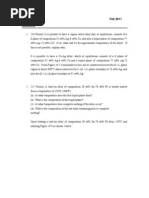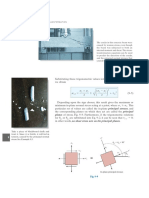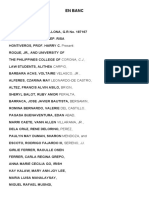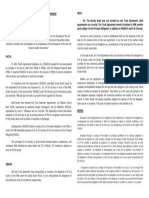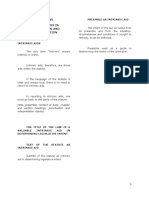Bulk Modulus
Uploaded by
Chi KoyBulk Modulus
Uploaded by
Chi KoyBULK MODULUS
Volume elasticity The bulk modulus (K) of a substance measures the substance's resistance to uniform compression. It is defined as the pressure increase needed to cause a given relative decrease in volume. Its base unit is the Pascal. Its the ratio of the stress on the body to the body's fractional decrease in volume. The modulus of elasticity for a material subjected to compression on all surfaces that is, volume stress. Bulk modulus is the relationship of volume stress to volume strain, expressed as the ratio between F/A and dV/Vo, where dV is the change in volume and Vo is the original volume. The bulk modulus K can be formally defined by the equation: K= -V P/V where P is pressure, V is volume, and P/V denotes the partial derivative of pressure with respect to volume. The inverse of the bulk modulus gives a substance's compressibility. Other moduli describe the material's response (strain) to other kinds of stress: the shear modulus describes the response to shear, and Young's modulus describes the response to linear strain. For a fluid, only the bulk modulus is meaningful. For an anisotropic solid such as wood or paper, these three moduli do not contain enough information to describe its behavior, and one must use the full generalized Hooke's law. When forces are applied to each surface of a cube, the cube experiences a strain on its volume. The volume will be reduced. In this case the volume stress is force per unit area (F/A). The volume strain is change in volume per unit volume ( V/V) K=volume stress/volume strain B= F/A / V/V Volume elasticity applies both to liquids and solids .
Gases are easily compressed and have very small coefficients and vary with pressure and temperature. Characteristics of materials which are closely related to the elastic properties are ductility, malleability, compressibility and hardness. Ductility Ductility is a mechanical property that describes the extent in which solid materials can be plastically deformed without fracture. Ductility is especially important in metalworking, as materials that crack or break under stress cannot be manipulated using metal forming processes, such as hammering, rolling, and drawing. Malleability Malleability, a similar concept, refers to a material's ability to deform under compressive stress; this is often characterized by the material's ability to form a thin sheet by hammering or rolling . Hardness Hardness is dependent on ductility, elasticity, plasticity, strain, strength, toughness, viscoelasticity, and viscosity. Common examples of hard matter are ceramics, concrete, certain metals, and super hard materials, which can be contrasted with soft matter.
You might also like
- Agpalo Notes - Statutory Construction, CH 450% (2)Agpalo Notes - Statutory Construction, CH 46 pages
- Academic Guidebook Chemical Engineering Department 2016 2017 EditionNo ratings yetAcademic Guidebook Chemical Engineering Department 2016 2017 Edition181 pages
- Agpalo Notes - Statutory Construction, CH 7No ratings yetAgpalo Notes - Statutory Construction, CH 71 page
- Foundation Design Handbook - Hydrocarbon Processing - 1974100% (4)Foundation Design Handbook - Hydrocarbon Processing - 197496 pages
- Engineering Materials and Their PropertiesNo ratings yetEngineering Materials and Their Properties23 pages
- Engineering Materials & Metallurgy Question Bank67% (3)Engineering Materials & Metallurgy Question Bank7 pages
- Solution Examples 1.3 - Mechanical Properties of Materials100% (2)Solution Examples 1.3 - Mechanical Properties of Materials26 pages
- Unit-I - Alloys and Phase Diagrams Part-A (2 Marks) : Question BankNo ratings yetUnit-I - Alloys and Phase Diagrams Part-A (2 Marks) : Question Bank10 pages
- Mech 3 Module 3 Unit 2 (Flanged Bolt Couplings)No ratings yetMech 3 Module 3 Unit 2 (Flanged Bolt Couplings)11 pages
- ME-1203 Solid Mechanics-EEE (Solved Problem Slide)No ratings yetME-1203 Solid Mechanics-EEE (Solved Problem Slide)9 pages
- Module 4: Activity No. 4: W MK Q 439.6 W, T W MKNo ratings yetModule 4: Activity No. 4: W MK Q 439.6 W, T W MK3 pages
- Unit IV Theories of Failure: Introduction: Due To Large Numbers of Examples of Compound Stresses MetNo ratings yetUnit IV Theories of Failure: Introduction: Due To Large Numbers of Examples of Compound Stresses Met23 pages
- Course: FLUID MECH 313 Fluid Statics: P Pressure, N/M F Force, N, Lb. A Area, MNo ratings yetCourse: FLUID MECH 313 Fluid Statics: P Pressure, N/M F Force, N, Lb. A Area, M16 pages
- Elastic Recovery After Plastic DeformationNo ratings yetElastic Recovery After Plastic Deformation23 pages
- Tensile Testing of Ferrous and Non-Ferrous Alloy100% (1)Tensile Testing of Ferrous and Non-Ferrous Alloy7 pages
- Review On Thermodynamics Plate No. 2: Instruction: Choose The Best Answer100% (1)Review On Thermodynamics Plate No. 2: Instruction: Choose The Best Answer10 pages
- ME2253 - Engineering Materials and Metallurgy QBNo ratings yetME2253 - Engineering Materials and Metallurgy QB3 pages
- Mechanical Behaviour, Testing and Manufacturing Properties of Materials100% (1)Mechanical Behaviour, Testing and Manufacturing Properties of Materials26 pages
- Neet - Physics - Properties of Bulk MatterNo ratings yetNeet - Physics - Properties of Bulk Matter19 pages
- Lecture Notes in Elasticity Pressure 2024No ratings yetLecture Notes in Elasticity Pressure 202417 pages
- Agpalo Notes - Statutory Construction, CH 8 and 9No ratings yetAgpalo Notes - Statutory Construction, CH 8 and 93 pages
- Conflict Rules Article 15. Laws Relating To FamilyNo ratings yetConflict Rules Article 15. Laws Relating To Family5 pages
- Agpalo Notes - Statutory Construction, CH 10100% (2)Agpalo Notes - Statutory Construction, CH 102 pages
- Agpalo Notes - Statutory Construction, CH 11No ratings yetAgpalo Notes - Statutory Construction, CH 112 pages
- Agpalo Notes - Statutory Construction, CH 6No ratings yetAgpalo Notes - Statutory Construction, CH 61 page
- Agpalo Notes - Statutory Construction, CH 5100% (3)Agpalo Notes - Statutory Construction, CH 52 pages
- The Philippine Animal Welfare Society (PAWS)No ratings yetThe Philippine Animal Welfare Society (PAWS)10 pages
- Agpalo Notes - Statutory Construction, CH 3No ratings yetAgpalo Notes - Statutory Construction, CH 34 pages
- (GR No. 179918, Sep 08, 2010) Shell Philippines Exploration B.V. V. Efren JalosNo ratings yet(GR No. 179918, Sep 08, 2010) Shell Philippines Exploration B.V. V. Efren Jalos1 page
- Contractual - Overall Schedule - PEMEX - 88 Weeks - CDU Heaters - R8No ratings yetContractual - Overall Schedule - PEMEX - 88 Weeks - CDU Heaters - R85 pages
- Finite Element Investigation On Plate Buckling Coefficients of Tapered Steel Members Web PlatesNo ratings yetFinite Element Investigation On Plate Buckling Coefficients of Tapered Steel Members Web Plates14 pages
- Environmentally Friendly Cooling With Heat: Ecoo 2.0: The Classic of Adsorption RefrigerationNo ratings yetEnvironmentally Friendly Cooling With Heat: Ecoo 2.0: The Classic of Adsorption Refrigeration3 pages
- Cold and Hot Water Demand Calculation Alfouzan100% (1)Cold and Hot Water Demand Calculation Alfouzan22 pages
- Error Codes For Komatsu Excavator's PC400-7, 400LC-7 - Electrical Equipment100% (2)Error Codes For Komatsu Excavator's PC400-7, 400LC-7 - Electrical Equipment4 pages
- International Journal of Heat and Mass Transfer: Mooyeon Lee, Yonghan Kim, Hosung Lee, Yongchan KimNo ratings yetInternational Journal of Heat and Mass Transfer: Mooyeon Lee, Yonghan Kim, Hosung Lee, Yongchan Kim7 pages
- Figure A.22.3.2 (B) : Section 22.4 Hydraulic Calculation ProceduresNo ratings yetFigure A.22.3.2 (B) : Section 22.4 Hydraulic Calculation Procedures8 pages
- API 521 7 Edition Ballot Item 6.4 Work Item 30 - Thermal Expansion Equation Definitions100% (1)API 521 7 Edition Ballot Item 6.4 Work Item 30 - Thermal Expansion Equation Definitions4 pages


































